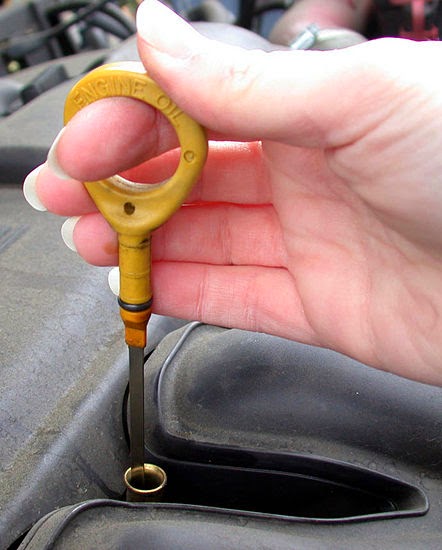Hi Bloggers,
1.
Your owner’s manual tells you when fluids must
be checked, but this is only the minimum to keep your warranty in check.
2.
Your car will need to be parked on a flat
surface and your engine will need to be cooled down.
3.
Open the hood of your vehicle.
4.
Check the motor oil: Make sure your car had
cooled down for at least an hour or so, so that the oil has drained down so you
do not get a false reading. Locate the oil dipstick and remove from its opening.
Use a paper towel or rag to wipe the dipstick clean so that you will have a
clear reading. Insert the dipstick into its opening and push it firmly all the
way back, as far as it will go. Pull it out all the way, this time reading the
oil level. When you are done, replace the dipstick back in its opening.
·
The dipstick will have markings on it indicating
a range for acceptable oil level. If your oil level is too low, appropriate motor
oil must be added before the car can be driven
5.
Check transmission fluid (only on automatic):
This is usually done with the engine running and fully warmed up, either in neutral
or parked, depending on the make and model. As with the oil locate it pull it
out, wipe it off push it all the way back in to the bottom of its travel, then
pull it out and read the level. Again look for a level between the two marks on
the dipstick.
·
Transmission fluid is reddish because it’s reasonably
fresh, it does not need to be changed as frequently as oil, but it does
occasionally need changing. If the transmission fluid looks brown, black or
burnt or its appearance suggests that it didn’t come out of a bottle lately,
consider replacing it.
6.
Check the brake fluid: Check your manual for the
location, or look around for a plastic reservoir labelled brake fluid. Wipe the
dirt off the outside, if you need to. It might help to push your car gently so
that the fluid level moves a bit. If you still can’t see it, take the cap off
and look in.
·
Cars
should not consume brake fluid. Low brake fluid can indicate either a leak in
the brake line or worn brake surfaces. If your brake fluid is low have your car
checked to find out why. If your vehicle has low brake fluid or leaking brake
fluid your car could fail to stop.
7.
Check the power steering fluid: This will generally also be a plastic
reservoir. Read through the walls as you did with the brake fluid, by opening
the lid and pouring more of an appropriate power steering fluid in. there may
be two pairs of lines, one for a hot engine and one for a cold engine. Read the
one that is appropriate to the current condition of your car.
8.
Check the coolant: Make sure the engine has
cooled down, otherwise scalding water could spray out as you open the
reservoir. The coolant will most likely be located in the reservoir up front
near the radiator.
·
Cars are designed to operate with antifreeze as
coolant, not water. Antifreeze is a mixture that has a lower freezing point,
and a higher boiling point than water. If you need to replace your coolant make
sure you purchase the right stuff.
·
Make sure you read the label on the antifreeze. Some
formulations are intended to be mixed half and half with water, others need to
be poured in at full strength.
9.
Check windshield washer fluid: Wiper fluid won’t
affect the performance of your car. There is no harm in having washer fluid
low, you will naturally use this up as you drive and clean your windshield. If you
are expecting very cold weather, be sure to use washer fluid that won’t freeze
in low temperature.
Until next time bloggers stay safe!!










.jpg)




0 comments:
Post a Comment